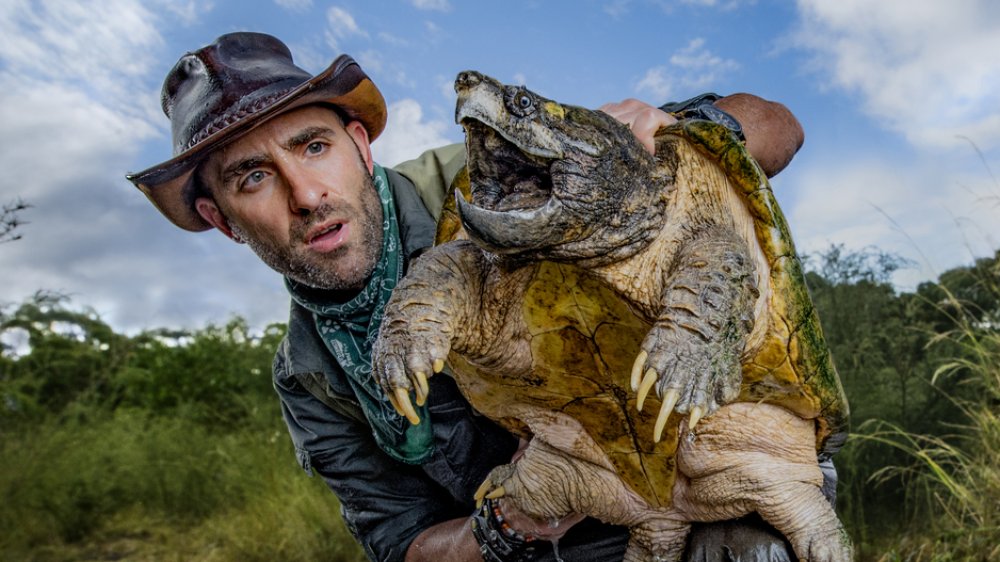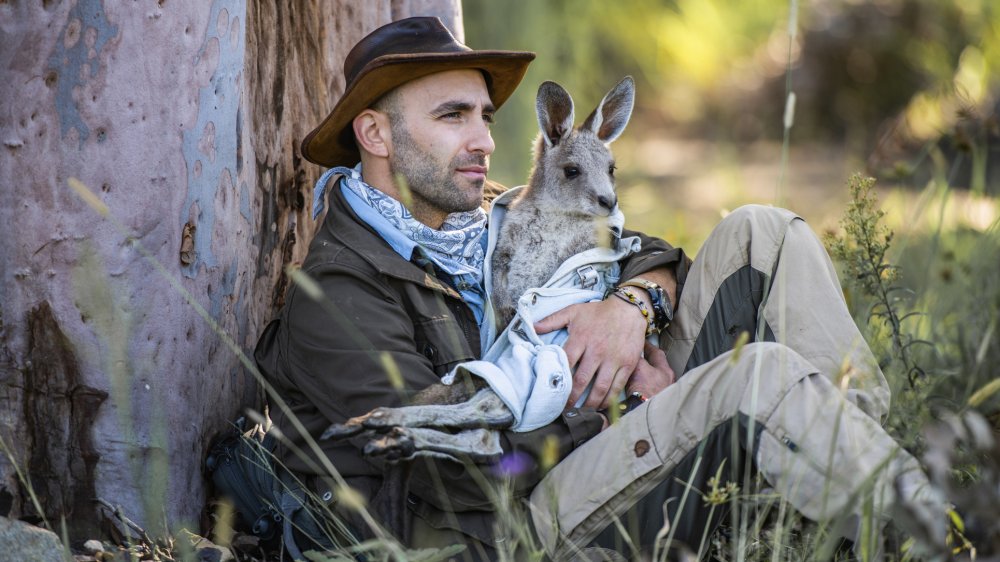The Truth About How Coyote Peterson Became An Animal Expert - Exclusive
Coyote Peterson, founder of the Brave Wilderness YouTube channel and host of the new Animal Planet series Brave the Wild, has a mission: getting up close and personal with the world's most dangerous and misunderstood critters, while teaching viewers something along the way. By Peterson's own admission, it's not a new idea. "I grew up on Steve Irwin and Jeff Corwin," Peterson says, "and I feel that we've done a good job carrying on that torch for the next generation of animal enthusiasts."
There's a big difference between those two broadcasting legends and Peterson, though. Corwin has a master's degree in wildlife conservation. Irwin grew up around the Queensland Reptile and Fauna Park, which his parents (both animal experts) founded. By contrast, Peterson studied film in college. Technically, he doesn't have any formal training.
"Look, you can't exactly go to school and learn how to interact with animals," Peterson told Looper. "There's no class on the face of the planet that's going to be like, 'All right, let's teach you how to interact with a venomous snake or catch an alligator or pick up a snapping turtle.'" That doesn't mean that Peterson doesn't know what he's doing, though. As he says, a lifetime spent around animals goes a long, long way.
As a child, Peterson was fascinated by snapping turtles, which he'd catch at locations like Thoreau Lake in his native Ohio (and which features in the very first episode of Brave the Wild, "Legendary Turtle of Texas"). "People don't normally think of a turtle as being something that's dangerous, but... if you get bitten by one of these things, they're incredibly fast. It's going to be a really bad bite," Peterson explained. "Learning to basically dodge the bites and claws of these turtles early on is really what primed me for interacting with all the other species that I've gotten up close with."
The rest came via Peterson's natural curiosity. "The world is full of free knowledge. You can go to a library and read books, you can search on the internet," Peterson said. "I've been teaching myself about animals since I was essentially old enough to read, so just absorbing all of that knowledge that's out there like a sponge gave me the background that I have."
That's basically how everyone else does it too, Peterson said. Mario Aldecoa, a trained biologist, is a permanent fixture on Brave Wilderness and Brave the Wild, but while he has a degree, he picked up most of his skills out in the field. "He grew up in South Florida, interacting with alligators and crocodiles and the venomous snakes down there," Peterson said. "His experience comes from the exact same stuff that I've gone through."
The learning process hasn't stopped now that Peterson is a star, either. When deciding which animals to go after next, Peterson and his crew sometimes just open an animal encyclopedia and look for the most interesting critter. They'll consult with local conservation groups before venturing to a location, and do plenty of outside research.
It's not just the animals themselves that Peterson studies, either. "You also have to be cognizant of poisonous plants, all kinds of things that you have to know about before you actually enter an environment and go off trail," Peterson said. "You never know what you're going to find."
The next Coyote Peterson? It could be you
Of course, formal education or not, by this point Peterson is an expert. If you try to do the things he does, especially some of the more dangerous stunts you can see him perform on Brave Wilderness, you're going to get seriously hurt. When Brave the Wild flashes its "don't try this at home" disclaimer, it's deadly serious.
Still, Peterson does have a few tips for aspiring animal handlers. "The most important thing you can do is educate yourself. Work hard in school, study," he said. To get experience with animals themselves, consider reaching out to local wildlife rehabilitation centers. "These organizations are in constant need of volunteer support. And you want to get hands-on with animals, you want to learn about animals, the best way to do that is to help the people that are already helping the animals."
Hosting your own show is a little easier. "It's amazing that we have outlets like Facebook and YouTube and Instagram and Snapchat," Peterson said. "Here are all of these ways for people to share their video content. Being a producer and a director has never been more possible than it is today." Just remember that while making videos looks fun, it's actually a lot of work. While filming Brave the Wild, Peterson still had to keep the Brave Wilderness channel going, posting new content to YouTube every week. "It was an incredibly difficult challenge to accomplish," Peterson admitted.
Finally, don't give up. "I was turned down by almost every network almost a decade ago when I started pitching the concept of doing an animal adventure series," Peterson said. "Then we went out, we created the brand and the following that we did on YouTube, and this opportunity re-presented itself. We took it on full charge to make the best animal adventure series we possibly could."
That persistence paid off. Brave Wilderness set Guinness World Records, and Peterson and Animal Planet are prepping a companion series to Brave the Wild that could debut as soon as this year. Not bad for a kid who just wanted to catch some turtles.

